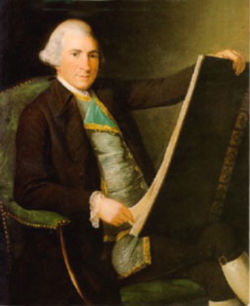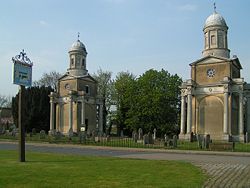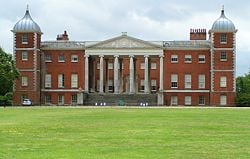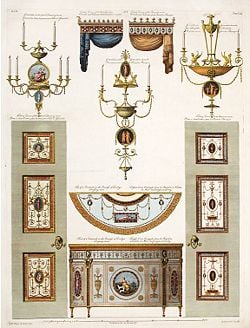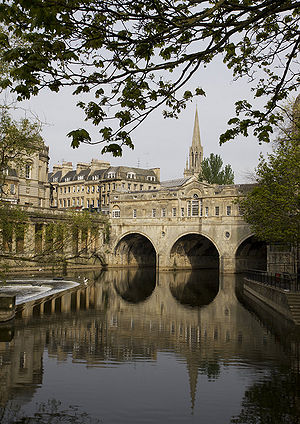Difference between revisions of "Robert Adam" - New World Encyclopedia
Lindsay Hull (talk | contribs) |
({{Contracted}}) |
||
| Line 1: | Line 1: | ||
| + | {{Contracted}} | ||
[[Image:Robert-adam.jpg|thumb|right|250px|Robert Adam]] | [[Image:Robert-adam.jpg|thumb|right|250px|Robert Adam]] | ||
'''Robert Adam''' ([[3 July]] [[1728]] – [[3 March]] [[1792]]) was a [[Scotland|Scottish]] [[neoclassicism|neoclassical]] [[architect]], [[interior designer]] and [[furniture designer]]. | '''Robert Adam''' ([[3 July]] [[1728]] – [[3 March]] [[1792]]) was a [[Scotland|Scottish]] [[neoclassicism|neoclassical]] [[architect]], [[interior designer]] and [[furniture designer]]. | ||
Revision as of 16:38, 10 October 2007
Robert Adam (3 July 1728 – 3 March 1792) was a Scottish neoclassical architect, interior designer and furniture designer.
Biography
Adam was born in Kirkcaldy, Fife, Scotland, the second son of William Adam (1689–1748), a stonemason and architect who was Scotland's foremost designer of country houses at the time. His younger brother and business partner James Adam was also an architect of some note, as was his older brother John Adam, although both were overshadowed by Robert.
He is considered by many to be the greatest architect of the late 18th century, and a leader of the neo-classical revival in England and Scotland from around 1760 until his death. Sir William Chambers was the leading British official architect of the era, but Adam received many important commissions from private clients and had a more lasting stylistic influence, termed the Adam style.
Training
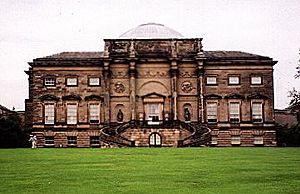
Robert studied at the Royal High School, Edinburgh, then entered the University of Edinburgh in 1743 only for his studies to be interrupted by illness and the Jacobite Rising of 1745. In 1746, he joined his elder brother, John Adam, as an assistant to his father, and after their father's death in 1748, the two brothers became partners in the family business, now known as 'Adam Brothers'.
Their first major commission was the decoration of the grand state apartments on the first floor at Hopetoun House, near South Queensferry west of Edinburgh, followed by projects at Fort George, Dumfries House and Inveraray. In 1754, Robert Adam set off for Europe on the Grand Tour of France and Italy, studying classical architecture and honing his drawing skills (his art tutors included French architect Charles-Louis Clérisseau and architect and archaeologist Giovanni Battista Piranesi). During this journey, he studied intensively the ruins of Diocletian's palace at Split in Dalmatia, later publishing The Ruins of the Palace of Diocletian in 1764.
Business
He returned to Great Britain in 1758 and set up in business in London with his brothers James and William, focused on designing complete schemes for the decoration and furnishing of houses. Palladian design was popular, and Robert designed a number of country houses in this style [1], but Robert evolved a new, more flexible style incorporating elements of classic Roman design alongside influences from Greek, Byzantine and Baroque styles.[2] The Adam brothers' success can also be attributed to a desire to design everything down to the smallest detail, ensuring a sense of unity in their designs.
Projects
- The Adelphi development, London
- Screen in front of the Old Admiralty, Whitehall, London
- Airthrey Castle, Stirlingshire (1791)
- Alnwick Castle, Northumberland (interiors)
- Apsley House, London (1778)
- Balbardie House
- Ballochmyle House, Ayrshire
- Bowood House, near Calne, Wiltshire
- Charlotte Square (north side), Edinburgh (1791)
- Culzean Castle, south Ayrshire (1772-1790)
- Dumfries House, Ayrshire (1754-1759)
- Edinburgh University Old College
- Fitzroy Square, London
- Gosford House, near Longniddry, East Lothian (1790–1800)
- Harewood House, West Yorkshire (1759-1771)
- Hopetoun House, West Lothian (interiors)
- Kedleston Hall, near Derby (1759-1765)
- Kenwood House, Hampstead, London (1768)
- Lansdowne House, Berkeley Square, London
- Luton Hoo, Bedfordshire (1766-1770)
- Marlborough House, Brighton (1786)
- Mellerstain House, Kelso, Scottish Borders (1760-1768)
- Mistley Towers
- Northumberland House, London, alterations (1770s)
- Nostell Priory
- Osterley Park, west London (1761-1780)
- Paxton House, near Berwick-upon-Tweed (1758)
- Portland Place, London (1773)
- Pulteney Bridge, Bath (1770)
- Register House, Edinburgh (1774-1789)
- Saltram House, Plymouth, Devon
- Shardeloes, Amersham, Buckinghamshire
- Stowe, Buckinghamshire (1774)
- Syon House interior, Brentford (1762-1769)
- Trades Hall, Glasgow, Scotland (1791-1792) (completed 1792-1802 by his brothers)
- Wedderburn Castle, Duns, Berwickshire (1770-1778)
Public life
Adam was elected a member of the Royal Society of Arts in 1758 and of the Society of Antiquaries in 1761, the same year he was appointed Architect of the King’s Works (jointly with Sir William Chambers). His younger brother James succeeded him in this post when he relinquished the role in 1768 in order to devote more time to his elected office as Member of Parliament for Kinross.
Robert Adam died suddenly at his home, 11 Albermarle Street, London, after a blood vessel in his stomach burst. He was 64. He was buried in Westminster Abbey. He left nearly 9,000 drawings, most of which were purchased by the architect John Soane and are now at the Soane Museum in London.
Further reading
- During their lifetime Robert and James Adam published two volumes of their designs, Works in Architecture of Robert and James Adam (in 1773-78 and 1779; a third volume was published posthumously, in 1822).
- A comprehensive account of Robert’s furniture work is given in The Furniture of Robert Adam by Eileen Harris (published by Alec Tiranti, London, 1963) ISBN 0-85458-929-5. Harris later published The Genius of Robert Adam: His Interiors (2001) ISBN 0-300-08129-4
- John Fleming, Robert Adam and his Circle (1962) ISBN 0-7195-0000-1
- Doreen Yarwood, Robert Adam (1970) ISBN 0-460-03824-9 and ISBN 0-460-02130-3 (1973 paperback)
- Damie Stillman, The Decorative Work of Robert Adam (1966) ISBN 0-85458-160-X
- Arthur T. Bolton, The Architecture of Robert & James Adam, 1785–1794, 2 volumes (1922, reprinted 1984) ISBN 0-907462-49-9 (1984 edition)
- James Lees-Milne's The Age of Adam (1947) is aimed at the general reader.
- A. A. Tait, ‘Adam, Robert (1728–1792)’, Oxford Dictionary of National Biography, Oxford University Press, 2004, doi:10.1093/ref:odnb/105
See also
- Adam style
- Angelica Kauffmann
ReferencesISBN links support NWE through referral fees
- ↑ Roth, Leland M. (1993). Understanding Architecture: Its Elements, History and Meaning, First, Boulder, CO: Westview Press, 397. ISBN 0-06-430158-3.
- ↑ Roth, Leland M. (1993). Understanding Architecture: Its Elements, History and Meaning, First, Boulder, CO: Westview Press, 402. ISBN 0-06-430158-3.
Credits
New World Encyclopedia writers and editors rewrote and completed the Wikipedia article in accordance with New World Encyclopedia standards. This article abides by terms of the Creative Commons CC-by-sa 3.0 License (CC-by-sa), which may be used and disseminated with proper attribution. Credit is due under the terms of this license that can reference both the New World Encyclopedia contributors and the selfless volunteer contributors of the Wikimedia Foundation. To cite this article click here for a list of acceptable citing formats.The history of earlier contributions by wikipedians is accessible to researchers here:
The history of this article since it was imported to New World Encyclopedia:
Note: Some restrictions may apply to use of individual images which are separately licensed.
